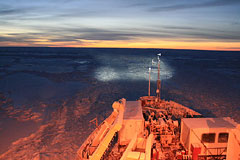

 | |||||||||
|
|
Journals 2007/2008Jason Pavlich
December 23, 2007 Position 71° 13.717' N 124° 10.421' W The engines started right on time this morning at 10 am. We headed about 50 nautical miles south of our position to our first sampling station of Leg 5. The crew was nice enough to let us watch them maneuver the ship through the ice. They didn't mind our presence on the bridge so long as we stayed quiet and out of the way so that they could focus on their jobs. The ship slowly completed a 30 point turn, backing up, and going forward while turning slightly over and over again. The ship can't back up into heavy ice because of the damage it might inflict on the propellers and rudder, so it has to create a space to turn around in. It cannot simply turn in a big wide circle because this would waste too much fuel breaking through the meter-thick ice. The idea was to follow the same path out of the land-fast ice (ice that is attached to the land) in order to save fuel as this ice will be much thinner than the ice that surrounds it. The ship can simply carve through thinner ice, but for thicker sections it is designed to ride up on top of the ice sheet, then crush it with its weight. One of the officers on deck told me that the ship is run by eight diesel generators. Three of these are used to power the ship, and the other five supply energy to the motors. When the ship is traveling through heavy ice as we will be doing today, it can burn 55 metric tons of diesel a day. In open water, the Amundsen burns one sixth of that in a 24-hour period. This is why the scientists and crew must be very careful when choosing the station. If they stop in the wrong place and the currents move the boat too fast, they must constantly correct by burning fuel. There is no refueling option for months. What we have onboard is what we will use until May. I headed out to the bow after lunch to witness the icebreaking up closer with Elizabeth Shadwick, graduate student from the University of Manitoba, and Bruce Johnson, a research associate also with U of M. The Amundsen soon encountered a ridge line of fairly thick ice that it was not immediately able to overcome. After three attempts of getting a running start, she finally rode high up on the ice and came crushing down through the ice. Words really cannot do justice to what I saw, heard, and felt as we made are way through the ice pack. I will try as hard as I can to describe to everyone when I get back what it was like but I will fall miserably short. This was simply one of those things that you have to experience for yourself. I am so lucky to be here.
Unfortunately I could not watch the passing ice all day as there was some work to be done. Amanda Chaulk and I had been given the assignment of updating the inventory list of the ship's chemical stockroom. This stockroom is located in the very front of the ship right around the waterline. Picture yourself in a small steel box, trying to read and write. Now, two people outside the box come along and not only violently shake the box, but pound on it with a sledgehammer. This was what our job like as the ship crashed through the Arctic ice. After about an hour, we had completed only half of our task but decided to finish later in the evening, possibly after the ship reached its destination. Neither of us could really hear anymore and our voices were gone from shouting chemical names, concentrations, and quantities at each other over a distance of a few feet. Dinner on Sundays is more formal then the others to break the monotony. It is very easy to lose track of what day it is, let alone the time of day. Scientists and some members of the crew that are not on duty linger long after the meal is over to share stories of past assignments and the first Arctic expeditions, both successful and unsuccessful. Away from work, it is very easy to forget where you are. Well, that is until you hear the mind numbing sound of a very large piece of ice scraping all the way down the hull, only a few feet from where you are sitting. Or if you need to step outside and your fingertips feel like they are being put in a vice because you did not put enough layers of gloves on. That stuff reminds you very quickly of where you are. Listen to the sound from inside the ship of ice scrapping against the hull. It's just after 9 pm now and the Amundsen has stopped. She will rest here tonight so that the crew will be able to get some sleep. I am told that I will be taking water samples tomorrow at 7 am before we continue on south. Let the work begin. |
||||||||
